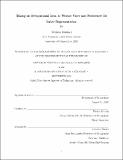Taking an occupational lens to worker voice and preference for labor representation
Author(s)
Kimball, William(William T.)
Download1227097164-MIT.pdf (1.756Mb)
Other Contributors
Sloan School of Management.
Advisor
Thomas Kochan.
Terms of use
Metadata
Show full item recordAbstract
Union density declined as the U.S. economy shifted away from production and membership rates stagnated or declined in the growing service or knowledge sector occupations. Recent collective actions among these occupations including union organizing, protests, and petitions suggest a potential infection point for unions and the labor movement. Yet, there are reasons to doubt whether existing labor forms and labor law can accommodate the interests of workers in these occupations with little experience in unions and collective bargaining. I use data from two nationally representative surveys to explore how preferences about voice and labor representation vary between occupation groups. I supplement this with a survey of professional and technical employees to gauge general and specific attitudes towards unions. My results show that some features of the U.S. labor union are widely desired, like collective bargaining, but alternative forms of labor organization that expand selective benefits, (cooperative) input to management, and make membership more flexible can substantially increase interest among the growing occupations in different ways. I discuss the implications for labor law reform and labor organizations' strategies.
Description
Thesis: S.M in Management Research, Massachusetts Institute of Technology, Sloan School of Management, September, 2020 Cataloged from student-submitted PDF version of thesis. Includes bibliographical references (pages 57-64).
Date issued
2020Department
Sloan School of ManagementPublisher
Massachusetts Institute of Technology
Keywords
Sloan School of Management.